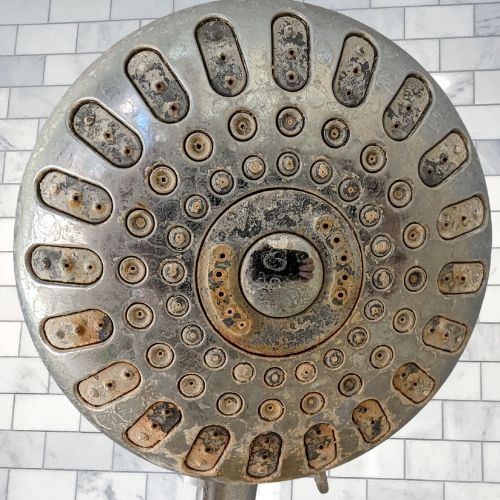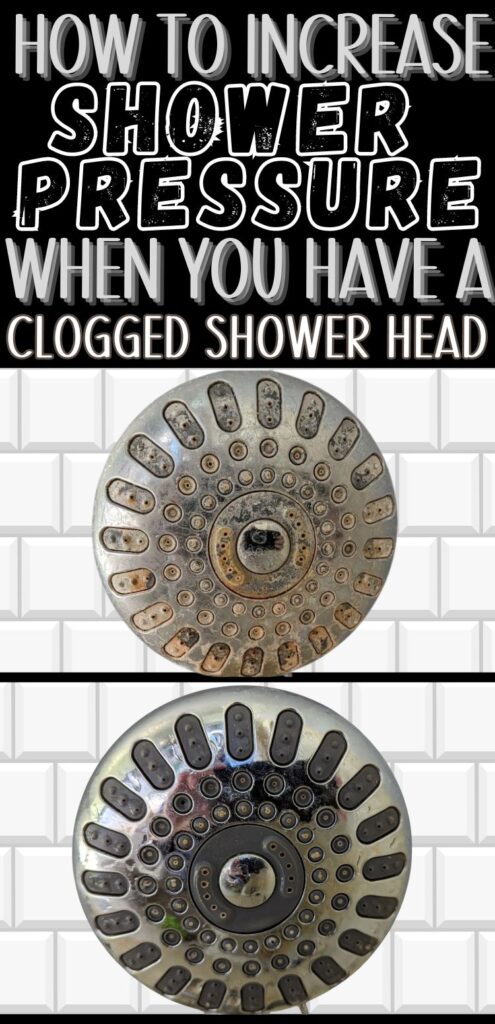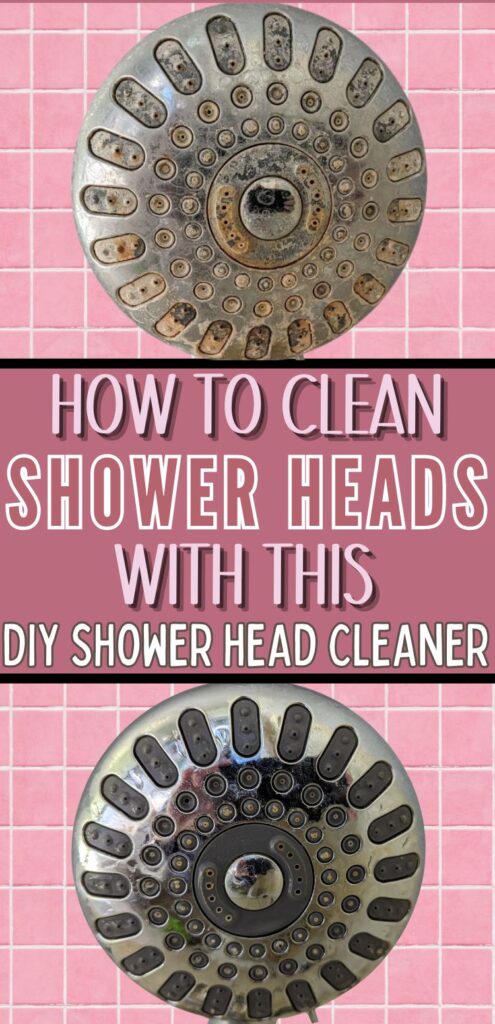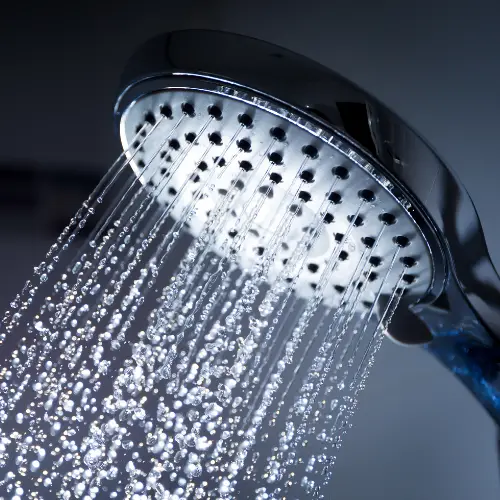This morning, I stepped into the shower, turned it on, and felt like I was standing under a gentle rain instead of the refreshing spray I was expecting. I turned off the shower and inspected the shower head. I had a clogged shower head. It was covered in crusty mineral deposits and had clogged nozzle holes.

This isn’t an uncommon occurrence around here. We’re on a well and have very hard water with high calcium and iron concentrations. Over time, minerals and debris build up in the nozzles of your shower head and cause low shower pressure.
As an Amazon Associate I earn from qualifying purchases. This means if you click on a link and buy something I’ve recommended, I get a small commission at no additional cost to you. You can see my full Disclosure Policy here.
Signs Of A Clogged Shower Nozzle
There are a few signs that you have a clogged showerhead, including:
Reduced Water Pressure
If the water pressure from your shower head is noticeably weaker than usual, it may be due to mineral buildup blocking the nozzles.
Uneven Spray Pattern
If the water sprays in various directions instead of a consistent stream, mineral deposits might be clogging some of the nozzles.
Visible Mineral Deposits
Check the shower head for white or greenish deposits around the nozzles. These are signs of hard water mineral buildup, typically calcium or lime.
Strange Noises
A hissing or sputtering noise when you turn on the shower can indicate that mineral deposits are affecting the water flow.
Inconsistent Water Temperature
If the water temperature fluctuates unexpectedly during use, it might be due to deposits affecting the mixing of hot and cold water.
Time Since Last Cleaning
If it has been a while since you last cleaned your shower head, it’s a good idea to check for buildup and clean it as a preventive measure so you can avoid the low water pressure blues.

How To Unclog a Shower Head
It’s been a few months since I’ve cleaned the shower head nozzle holes, and showers without water pressure suck, so I postponed my shower. Instead, I started making my DIY shower head cleaner with citric acid. Here’s the step by step process I used to clean the clogged shower head.
How to Clean Your Shower Head with Citric Acid
Citric acid is a fantastic, natural cleaner for this job. Like vinegar, the acid in citric acid reacts with the minerals and dissolves them so they get washed away. Here’s how to clean a showerhead step-by-step.
NOTE THAT CITRIC ACID MAY ETCH STONE SUCH AS MARBLE. TAKE PRECAUTIONS TO PROTECT NATURAL STONE.
Supplies Needed
- Citric acid powder (or vinegar if you have no citric acid)
- Very warm water (not required if using vinegar)
- A bowl or a plastic bag
- Rubber bands or a twist tie
- A soft cleaning brush
Make The Citric Acid Solution
In a large bowl, dissolve ¼ cup of citric acid powder in a quart of very warm water. This creates a powerful solution that will dissolve that mineral buildup. You can substitute a quart of vinegar if you don’t have the citric acid.
Prepare the Shower Head
If you have a handheld shower sprayer that’s long enough, you can just drop it into the bowl. If it’s too short, remove the shower head.
For a stationary shower head, remove the shower head if you can. Most stationary shower heads can be unscrewed. If not, no worries – you can clean it while it’s still attached.
Soak the Shower Head
Removable Shower Heads
Submerge the shower head in the bowl of citric acid solution (or vinegar). If it tries to float, anchor it down with a heavy, solid object so that it stays in the solution.
Non-Removable Shower Heads
Fill a plastic bag with the solution (or vinegar), place it over the shower head, and secure it with rubber bands or a twist tie. Make sure the nozzles are fully immersed.
Let it Soak
Leave it to soak for 2-3 hours. The acids will dissolve the mineral deposits causing the clog.
Scrub Remaining Residue
After soaking, remove the bag if you used one. Use a cleaning brush to scrub the nozzles and any remaining buildup.
Rinse Thoroughly
Rinse the shower head with warm water to wash away any loosened debris and citric acid residue. If you have a stationary shower head, pour a few cups of warm water over it.
Reattach and Test Your Shower Head
If you removed the shower head, reattach it securely. Run hot water through it for a few minutes to ensure it’s working perfectly. If a nozzle is still clogged, use a pin to loosen the debris.

Additional Tips and Shower Cleaning Hacks To Maintain Your Shower Head
You can use Coca Cola or Pepsi
If you don’t have any citric acid or vinegar in the house, you can also use undiluted Coca Cola or Pepsi instead. The phosphoric acid in these soft drinks will dissolve those deposits in no time. Just remember to rinse the shower head thoroughly afterwards.
Routine Maintenance
Regular cleaning helps prevent buildup. Aim to clean your shower head every few months and avoid that annoying low water pressure.
Use This DIY Shower Head Cleaner
Citric acid is a great natural alternative to harsh chemicals. It’s also a good way to clean without vinegar, especially if you don’t like the smell.
Repeat If Necessary
For stubborn deposits, you might need to repeat the soaking process or use a bit more elbow grease to remove all the limescale.
You can also use this solution to easily remove rust stains from bathtubs, clean shower doors and to get stubborn stains off toilet bowls.

Other Causes of Low Water Pressure
If you’ve tried this method and you’re still experiencing low water pressure, the problem could be somewhere else:
Plumbing Issues
Sometimes, the problem isn’t the shower head but the plumbing. Corroded pipes, leaks, or blockages can reduce water flow.
Water Supply Problems
If your whole house has low pressure, it could be an issue with the municipal water supply or your pressure regulator.
Faulty Fixtures
A broken, leaky or old shower head might not work as efficiently, causing reduced water pressure. It may be time to buy a new shower head.
Maintenance Tips
- Regularly wipe down the shower head with a dry cloth after each use to minimize mineral deposits.
- Once a week, spray some of the citric acid solution on your shower head to minimize buildup.
- To prevent future mineral buildup, consider cleaning your shower head with citric acid every few months.
These steps should effectively remove mineral buildup from your shower head, restoring its function and appearance. Happy showering!

